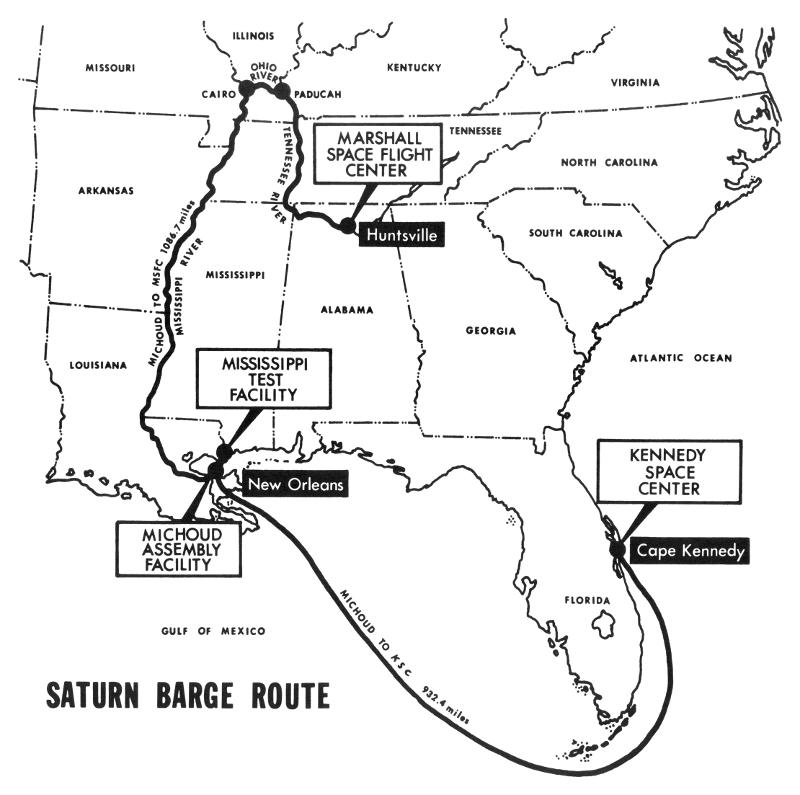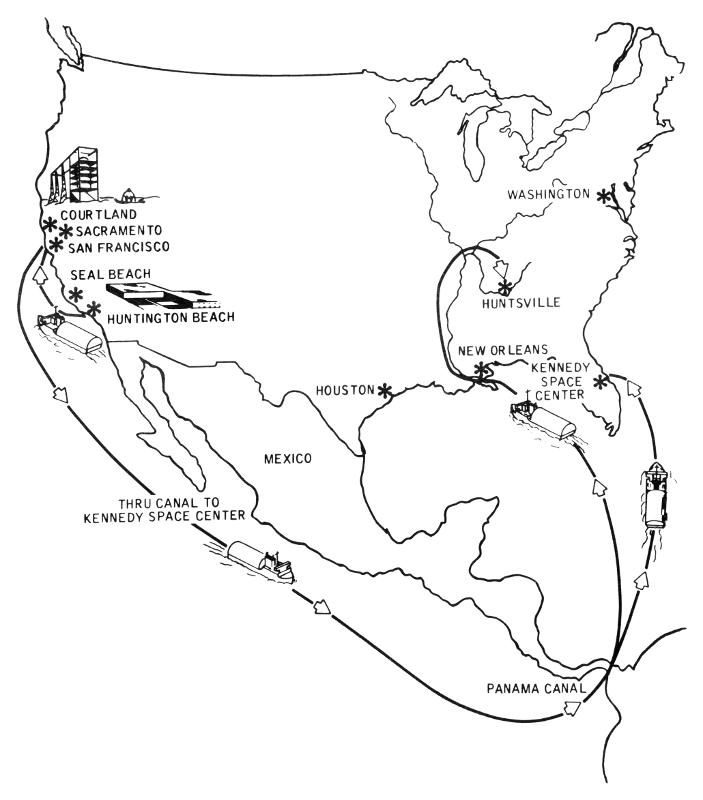Saturn Barge Routes
Due to their sheer size, most stages of Saturn rockets travelled via barge (although the S-IV and S-IVB stages were generally transported, respectively, via "Pregnant Guppy" or "Super Guppy" aircraft, converted Boeing 377 Stratocruisers; the Boeing 377 itself was derived from the Air Force's C-97 Stratofreighter).
The first stages of all of the Saturns were built either at Marshall Space Flight Center in Huntsville, Alabama or the Michoud Assembly Facility in New Orleans, Louisiana. These stages underwent static testing at either MSFC (all of the S-I and S-IB stages, as well as the first three S-IC stages) or at the Mississippi Test Facility (later renamed the Stennis Space Center) and were launched from Kennedy Space Center in Florida.
The following diagram shows the barge routes for the Saturn first stages between MSFC, MAF, MTF, and KSC:
Click image for a 4441x4412 pixel version of this image in a new window.
From p. 11A of the Apollo 4 Press Kit. Located in the Kramer
Collection, Dept. of
Archives/Special Collections, M. Louis Salmon Library, University of
Alabama in Huntsville, which also makes this document available as a 11
megabyte PDF.
Scan and clean-up by heroicrelics.
This diagram depicts an open-ocean route (precisely 932.4 miles!) around Florida's south coast for the voyage between the mouth of the Mississippi River and KSC. Stages to Saturn describes a different route:
After leaving the Mississippi, the barge and tug followed the Gulf Intracoastal Waterway to St. George Sound, located off the Florida panhandle; across the Gulf of Mexico to San Carlos Bay (near Ft. Myers); through the Okeechobee Waterway across Florida to Stuart, on the Atlantic Coast; then up the Florida Intracoastal Waterway to the Cape Canaveral Barge Canal. The complete voyage from Huntsville covered about 3500 kilometers and took 10 days; by using the Intracoastal Waterway, the barge and its cargo traveled only 452 kilometers in open seas, and the route kept them no more than 80 kilometers from sheltered ports along the Gulf Coast.
The Apollo 4 Press Kit mentions the "intercoastal [sic] waterways" and cites the distance between Huntsville and KSC as "more than 2,200 miles"; the 3,500 km referenced by Stages to Saturn converts to about 2,174 miles. The graphic gives a distance of 1,086.7 miles from Michoud to MSFC and 932.4 miles from MAF to KSC (for a total of 2019.1 miles). Given all this, I assume that the artist has taken some artistic license regarding that leg of the route.
The following diagram represents the barge routes for the stages manufactured in California: The Saturn V S-II (second) stage (manufactured by North American Rockwell in Seal Beach) and the S-IVB stage (manufactured by Douglash Aircraft Company in Huntington Beach), used as the second stage of the Saturn IB and the third stage of the Saturn V.
Click image for a 4123x4694 pixel version of this image in a new window.
From p. 11B of the Apollo 4 Press Kit. Located in the Kramer
Collection, Dept. of
Archives/Special Collections, M. Louis Salmon Library, University of
Alabama in Huntsville, which also makes this document available online.
Scan and clean-up by heroicrelics.
Too large for the Guppy aircraft, the S-II was barged through the Panama Canal for static firing at MTF and launch at KSC. S-II stage transport would actually originate at Seal Beach and head south through the Panama Canal, rather than stopping off at Courtland.
Although the S-IVB was generally transported via Super Guppy, the occasional stage was transported via barge from its manufacturing plant in Huntington Beach to Sacramento Test Operations (SACTO) for static firing or to KSC for launch.


